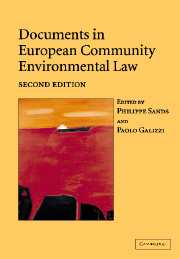Book contents
- Frontmatter
- Contents
- Preface
- PART I General principles of EC environmental law
- PART II European Community institutions and legislation
- PART III The relationship between environmental protection, financial assistance and free trade
- PART IV Procedural techniques of environmental protection
- 13 Council Directive 85/337/EEC of 27 June 1985 on the assessment of the effects of certain public and private projects on the environment (OJ L 175 05.07.1985 p. 40)
- 13A Directive 2001/42/EC of the European Parliament and of the Council of 27 June 2001 on the assessment of the effects of certain plans and programmes on the environment (OJ L 197 21.07.2001 p. 30)
- 14 Council Directive 96/61/EC of 24 September 1996 concerning integrated pollution prevention and control (OJ L 257 10.10.1996 p. 26)
- 15 Recommendation 2001/331/EC of the European Parliament and of the Council of 4 April 2001 providing for minimum criteria for environmental inspections in the Member States (OJ L 118 27.04.2001 p. 41)
- 16 Directive 2003/4/EC of the European Parliament and of the Council of 28 January 2003 on public access to environmental information and repealing Council Directive 90/313/EEC (OJ L 41 14.02.2003 p. 26)
- 17 Directive 2003/35/EC of the European Parliament and of the Council of 26 May 2003 providing for public participation in respect of the drawing up of certain plans and programmes relating to the environment and amending with regard to public participation and access to justice Council Directives 85/337/EEC and 96/61/EC (OJ L 156 25.06.2003 p. 17)
- 18 Directive 2004/35/EC of the European Parliament and of the Council of 21 April 2004 on environmental liability with regard to the prevention and remedying of environmental damage (OJ L 143 30.04.2004 p. 56)
- PART V Protection of air quality
- PART VI Biodiversity and nature conservation
- PART VII Waste
- PART VIII Dangerous substances
- PART IX Water quality
18 - Directive 2004/35/EC of the European Parliament and of the Council of 21 April 2004 on environmental liability with regard to the prevention and remedying of environmental damage (OJ L 143 30.04.2004 p. 56)
from PART IV - Procedural techniques of environmental protection
Published online by Cambridge University Press: 06 January 2010
- Frontmatter
- Contents
- Preface
- PART I General principles of EC environmental law
- PART II European Community institutions and legislation
- PART III The relationship between environmental protection, financial assistance and free trade
- PART IV Procedural techniques of environmental protection
- 13 Council Directive 85/337/EEC of 27 June 1985 on the assessment of the effects of certain public and private projects on the environment (OJ L 175 05.07.1985 p. 40)
- 13A Directive 2001/42/EC of the European Parliament and of the Council of 27 June 2001 on the assessment of the effects of certain plans and programmes on the environment (OJ L 197 21.07.2001 p. 30)
- 14 Council Directive 96/61/EC of 24 September 1996 concerning integrated pollution prevention and control (OJ L 257 10.10.1996 p. 26)
- 15 Recommendation 2001/331/EC of the European Parliament and of the Council of 4 April 2001 providing for minimum criteria for environmental inspections in the Member States (OJ L 118 27.04.2001 p. 41)
- 16 Directive 2003/4/EC of the European Parliament and of the Council of 28 January 2003 on public access to environmental information and repealing Council Directive 90/313/EEC (OJ L 41 14.02.2003 p. 26)
- 17 Directive 2003/35/EC of the European Parliament and of the Council of 26 May 2003 providing for public participation in respect of the drawing up of certain plans and programmes relating to the environment and amending with regard to public participation and access to justice Council Directives 85/337/EEC and 96/61/EC (OJ L 156 25.06.2003 p. 17)
- 18 Directive 2004/35/EC of the European Parliament and of the Council of 21 April 2004 on environmental liability with regard to the prevention and remedying of environmental damage (OJ L 143 30.04.2004 p. 56)
- PART V Protection of air quality
- PART VI Biodiversity and nature conservation
- PART VII Waste
- PART VIII Dangerous substances
- PART IX Water quality
Summary
Editorial note
Directive 2004/35/EC of 21 April 2004 establishes a framework of environmental liability based on the polluter pays principle, to prevent and remedy environmental damage (Article 1). The Directive defines several terms to be used in its applications, including ‘environmental damage’ (Article 2(1)); ‘damage’ (Article 2(2)); ‘occupational activity’ (Article 2(7)); ‘preventive measures’ (Article 2(10)); ‘remedial measures’ (Article 2(11)); and ‘costs’ (Article 2(16)).
The Directive applies to environmental damage and to any imminent threat of such damage caused by any of the occupational activities listed in Annex III. Damage to protected species and natural habitats caused by any occupational activities other than those listed in Annex III, and any imminent threat of such damage, is also covered whenever the operator has been at fault or negligent (Article 3). The Directive does not cover environmental damage resulting from an armed conflict or a natural phenomenon (Article 4(1)). The Directive does not apply to environmental damage or threat of such damage in respect of which liability is regulated under any of the international conventions listed in Annex IV (Article 4(2)). Other exceptions include nuclear damage (covered by either the Euratom Treaty or falling under one of the international liability regimes listed in Annex V) (Article 4(4)). The Directive applies to damage caused by pollution of a diffuse character only if it is possible to establish a causal link with activities of an individual operator (Article 4(5)). Activities whose main purpose is to serve national defence or international security or the sole purpose of which is to protect from natural disasters are excluded from the application of the Directive (Article 4(6)).
- Type
- Chapter
- Information
- Documents in European Community Environmental Law , pp. 363 - 388Publisher: Cambridge University PressPrint publication year: 2006
- 3
- Cited by



